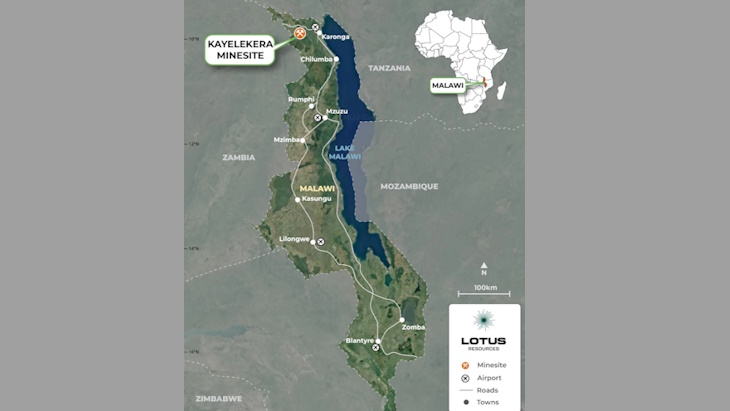Lotus Resources says it can reopen the Kayelekera uranium mine in Malawi in 8-10 months - much quicker than its previous 15 month estimate. It is now targeting production in the third quarter of 2025.
The accelerated restart plan, which follows the completion of a Front-end Engineering and Design (FEED) programme, targets production of 19.3 million pounds U3O8 over a 10-year mine life. Lotus is now moving into detailed engineering and onsite works for Kayelekera’s restart.
The accelerated restart is made possible by taking a phased approach to both the completion of on-site infrastructure and to restart capital, and is derisked by 11 million pounds U3O8 of historical uranium production, with USD200 million already invested into the plant and operations and existing stockpiles to support the ramp-up of the operation.
The company’s board has already approved long lead item orders, mobilisation of mobile equipment and construction crews and early works. It has been able to proceed with the restart using AUD34 million (USD23 million) of existing cash funding (as of 30 June). In parallel with this, it is also continuing to assess an “optimal funding mix” of funding from debt, prepayment sources, commodity finance, strategic and cornerstone funding sources, and expects restart, post production and working capital to come from a mix of these sources, as well as from the cashflow from operations.
CEO Greg Bittar said the FEED process has provided the foundation for Lotus to optimise and accelerate its restart plans, taking advantage of the existing plant and infrastructure. “By sequencing the capital spend and targeting the critical restart items we reduce the amount of initial restart capital, which allows us to turn the plant on much earlier than previously contemplated. This not only provides us with increased funding flexibility but critically allows us to be a producer next year and take advantage of the strong customer demand we are seeing by moving into production as soon as possible,” he said.
“By decoupling the restart timetable from the long lead items which are not on the operational critical path, principally the connection to the power grid and acid plant rebuild, we are able to start the plant well ahead of the original DFS schedule of 15 months.”
Those capital items remain in the plan, but “we don’t need to wait for those, or have the timetable to restart dependent on those, items,” Bittar added. “The plan was always to have full back up diesel power generation, as the site was originally operated by, and we can use this power while the grid connection is completed. Trucked-in sulphuric acid can be used until the acid plant is commissioned.”
Kayelekera is 85% owned by Australian company Lotus, which acquired it from Paladin Energy in 2020. It produced around 11 million pounds U3O8 between 2009 and 2014, when it was placed on care and maintenance, and has total resources of 51.1 million pounds including 4.8 million pounds of inferred resources at the Livingstonia deposit. Lotus announced inaugural mineral resources for the deposit, which is a potential satellite operation to Kayelekera, in June 2022.


